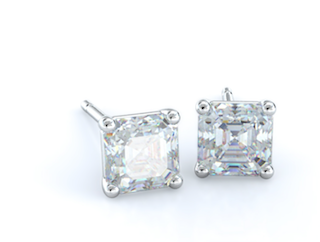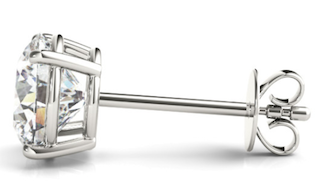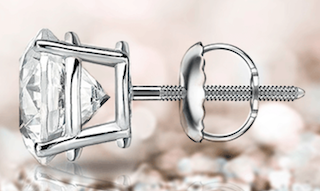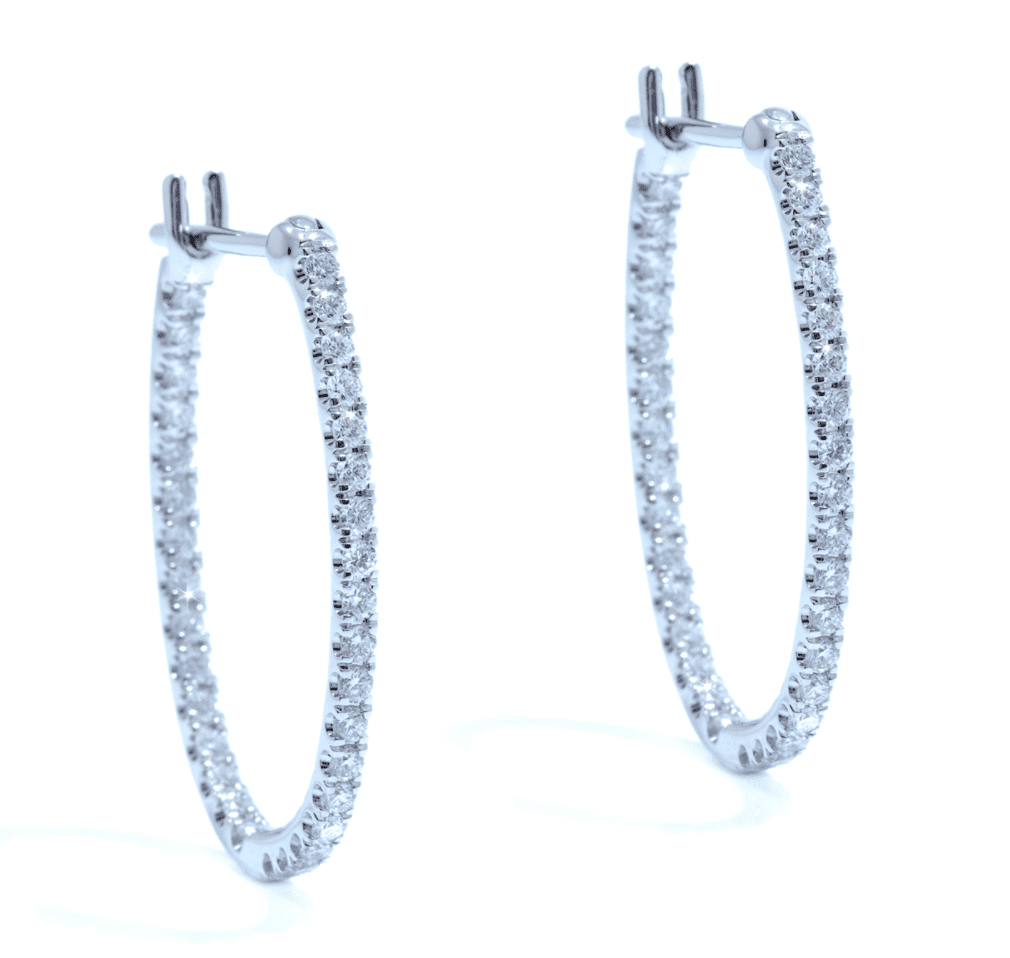Diamond Earrings For Women
Few jewelry items are as timeless and elegant as diamond earrings. There are various sizes, cuts, and designs available to suit any occasion! You might think that all diamond earrings are created equal, however, there are tons of different options available. You can even choose settings that differ in how they hold the diamonds in your ear! As designs become more ornate, different setting styles can secure the earrings better than others. There are also multiple ways for individuals who do not have pierced ears to wear diamond earrings!
Diamond Studs - the LBD of earrings

We begin with the most basic setting option: studs. Studs feature stones directly connected to a post. This may be a plain metal design, feature a single or multiple small stones, or a combination of the two. When speaking about single diamond designs, there are two main setting categories for you to select from: basket or martini.

Basket settings are the most common and they look exactly like what their name implies. Baskets have a flat bottom and suspend diamonds slightly removed from your ear lobe. Conversely, martini settings are v-shaped and have the same silhouette as the top of martini glasses when viewed from the side.Martini settings nestle the diamonds more deeply in your piercing than baskets do and, thus, hold them closer to your ear.

As baskets hold stones higher than martinis, some believe that they showcase the diamonds better. However, if you are wearing larger diamond (about 1 carat and up depending on the thickness of your ear lobe), or multiple stones, their weight makes them susceptible to drooping. Martini settings don’t hold the stones out, but, by keeping them closer to your ear, the larger options don’t pull down as much. Thus, martini settings can be a good alternative for individuals with thin or stretched ear lobes.
Both basket and martini settings can hold diamonds with three or more prongs. Unlike rings, earrings are innately secure as they are not at risk of brushing against, or hitting, other objects. So, when it comes to studs, feel free to choose whatever setting style that makes you happiest!
Types of backs
Whether you wear simple studs or are showing off some seriously awesome diamond drop earrings, there are several earring backings to choose from, each with different attributes.
Tension (push) Backs

You are probably most familiar with “tension” backs. These are by far the most common style and secure enough to accommodate most designs. The post of the earring has a notch at the far end and you simply slide a backing over that notch to secure the earring. Simply pull to release and you’re done!
Screw Back

A variation on the tension closing is the “threaded-post”, otherwise known as the screw back, option. While the tension back slides onto the smooth post, threaded posts have grooves which the backing twists on to close. Like regular tension backs, you can choose where to stop the squeezing so individuals with thin ear lobes can wear the same earrings as individuals with thicker lobes without any modifications needed.
Lever backs
Unlike tension backs which use a separate backing component, “lever” settings are a single unit. There is a post which goes through your piercing and a movable metal part that swings upwards to meet the post, thereby securing the earring. For more valuable designs, you may consider the lever-back’s cousin setting, the “omega clip”. Like lever-backings, omega clips are an all-in-one design. A loop is connected to the post which flips closed after you slide the post through your piercing. As the earring holds itself together, there is little risk of it inadvertently falling out without your notice.
Shepherd's Hook
There are also basic “fish hook” or “shepherd’s hook” closures, however, these may not be the most secure option if you are wearing valuable diamonds. As a result, it is unlikely that you will even find diamond earrings which use this setting system, at least without special modifications. If you do wear them, I recommend finding separate backings for added protection. Many jewelry and craft stores carry parcels of extra backings which slip onto the hook and hide behind your ear lobe.
Clip Ons
For those of you without pierced ears, don’t worry, there are options for you! To accommodate non-pierced individuals, “screw backings” and “clip-ons” both use pressure to hold earrings to your ear. Both settings were invented around the early nineteen hundreds when it became fashionable to pull one’s hair back and show the ears. They are never going to be as secure as a tension or omega setting, but they will allow you to wear earrings. Just wear expensive jewelry with care.
Other Earring Styles
Hoops

There are a few fundamental diamond earring designs that jewelers build upon to create their art. We have already covered studs that describe diamonds of any size or shape affixed directly to a straight post. Other earring designs are hoops earrings, which can range from the smallest “huggies”, only big enough to encircle your ear lobe, to large, statement, options which can swing down to your shoulders or lower! Individual hoops may connect to form an uninterrupted circle but there is no rule that says the ends have to meet. They may be thin or super chunky!
Chandelier
Another earring option that hangs down is the “chandelier” earring. This design has infinite interpretations and refers to drop styles that dangle from your ear. Chandeliers can be minimal or intricate. The opposite of chandelier earrings are “ear crawlers” or “ear trims”. As opposed to hanging down, these designs are meant to sit upright and climb your ear. Similarly, “ear cuffs” do not require piercings and slide onto the outside ridge of your ear. This style has gained popularity in recent years.
Jackets
Finally, “earring jackets” are extra jewelry pieces that can be added to any earring with a post. They have a small open circle at the top through which you insert the post of your earring before securing the backing. Usually, jackets are used to supplement modest styles which don’t already have built-in drops. These can be plain metal but, more commonly, they are adorned with additional diamonds and/or other gemstones for extra sparkle! Using similar techniques, some chandelier designs can be extended to multiple levels.
Now, you can use your knowledge of these fundamental settings and designs to locate your ideal diamond earrings for all occasions!

